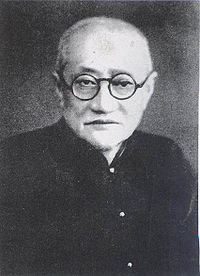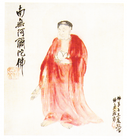Views
Wáng Yītíng 王一亭 (1867-1938)
|
| Notable Associates: |
|
Wáng Yītíng 王一亭 (1867-1938) was a famous painter and calligrapher of the Republican period, Wáng was also a noted industrialist and lay Buddhist. He was involved with founding some of the major Buddhist organizations of the period, including the dominant Buddhist publishing house, Shanghai Buddhist Books 上海佛學書局.
Contents |
Biography
At 13, Wáng went to Shànghǎi to study, and later became a student at the Guǎngfāng yánguǎn 廣方言館, where he studied foreign languages. It was at this time that his teachers noticed his painting abilities, and he began to show his paintings.
At 20, he began working at Tiānyú hào 天餘號, a shipping company run by Lǐ Píngshū 李平書.
In 1907 (Guāngxù 光緒 33), he got a job as a comprador with a Japanese steamship company. And in 1910, he and others (including Lǐ and Chén Qíměi 陳其美) founded the newspaper Mínlì bào 民立報 (The People's News). He also joined Sun Yat-sen's Revolutionary Alliance 同盟會 that year. In October 1910, he joined Dí Chǔqīng 狄楚青 and others in establishing a Buddhist Research Society 佛學研究會 in Nánjīng 南京, headed by Yáng Wénhuì 楊文會.[1]
After the Revolution of 1911, Wáng was put in charge of the new government bureau overlooking agriculture, industry, and business in Shànghǎi 上海.
Wáng had been a believer in Buddhism since he was young. He took refuge under Yìngqián 應乾 at Liúyún Temple 留雲寺 in Shànghǎi. He had a Buddhist altar in his home, and he chanted the name of Guānyīn 觀音 daily. After 1913, he dedicated himself to charitable activities, including building housing, a library, and a hospital. In the summer of 1915 he went on pilgrimage to Mount Pǔtuó 普陀山 and visited Tǎixū 太虛, who was in seclusion 閉關 there.[2]
In 1918, he became vice-president of the newly formed Shànghǎi World Lay Buddhist Association 上海世界佛教居士林, which split in 1922 into the World Lay Buddhist Association 世界佛教居士林 and the Shànghǎi Buddhist Pure Karma Society 上海佛教淨業社. He was involved with the publication of the latter group's periodical, the magazine of the World Buddhist Lay Association 世界佛教居士林林刊.
In 1925, he was part of the delegation that attended the East Asian Buddhist Conference 東亞佛教大會 in Japan, along with Tàixū 太虛, Dàojiē 道階, and Hú Zǐhù 胡子笏.
In 1926, he and others formed the Shanghai Buddhist Restoration Association 上海佛教維持會 to help rebuild temples in China. The following year, 1927, he became the president of the World Lay Buddhist Association. In 1929, he was involved in writing the charter for the Chinese Buddhist Association 中國佛教會. That year he and Lǐ Jīngwěi 李經緯 founded Shànghǎi Buddhist Books 上海佛學書局.[3]
Wáng continued to paint, and the Emperor of Japan even viewed his paintings, which sold for tens of thousands of yuán 元 in Japan. He used the money he earned from his painting for charitable activities.
In 1937, he fled Shànghǎi for the inner provinces, but while en route in Hong Kong 香港, he became ill. After convalescing in Hong Kong for one year, he returned to Shànghǎi, where he passed away on November 13, 1938.
Important Works
- Báilóng shānrén huàjí 白龍山人畫集 (Collected Paintings of the White Dragon Mountain Man)
- Ershísì xiào huàjí 二十四孝畫集 (Collection of Twenty-four Filial Paintings?)
- Kǒngzǐ zhéxué 孔子哲學 (Confucius' Philosophy)
- Wáng Yìtíng xuǎnjí 王一亭選集 (Selected Works of Wáng Yìtíng)
- Wáng Yìtíng tí huà shī xuànjí 王一亭題畫詩選集 (Selected Inscriptions, Paintings, and Poems of Wáng Yìtíng)
Gallery
| Paintings by Wáng Yìtíng | |||||||||
| |||||||||
Notes
- ↑ Wang Zhongxiu, 66.
- ↑ Wang Zhongxiu, 148.
- ↑ Wang Zhongxiu cites an August 20, 1929, issue of Shēnbào 申報 reporting on the preparations to establish the press.
References and Resources
- Chén Zǔēn 陳祖恩, Lǐ Huáxīng 李華興. Báilóngshānrén - Wáng Yìtíng zhuàn 白龍山人 - 王一亭傳 (White Dragon Mountain Man: The Story of Wáng Yìtíng). Shànghǎi: Shànghǎi císhū chūbǎnshè, 2007.
- Kāng Bào 康豹 (Paul R. Katz). "一個著名上海商人與慈善家的宗教生活: 王一亭" (The Religious Life of a Renowned Shanghai Businessman and Philanthropist: Wang Yiting) in Cóng chéngshì kàn Zhōngguó de xiàndàixìng 從城市看中國的現代性 (The City and Chinese Modernity), edited by Wu et al, 275-296. Taipei: Academia Sinica, Institute of Modern History, 2010.
- Wáng Zhōngxiù 王中秀, ed. Wáng Yìtíng niánpǔ chāngbiān 王一亭年譜長編 (Long Volume of Wáng Yìtíng's Chronology). Shànghǎi: Shànghǎi shūhuà chūbǎnshè, 2010.
- Shì Dōngchū 釋東初. Zhōngguó Fójiào jìndài shǐ 中國佛教近代史 (A History of Early Contemporary Chinese Buddhism), in Dōngchū lǎorén quánjí 東初老人全集 (Complete Collection of Old Man Dongchu), vols. 1-2. Taipei: Dongchu, 1974 Pp. 2.507-510.
- Yú Língbō 于凌波, ed. Xiàndài Fójiào rénwù cídiǎn 現代佛教人物辭典 (A Dictionary of Modern Buddhist Persons), 2 vols. Taipei: Foguang, 2004. Pp. 1.152b-154b.

